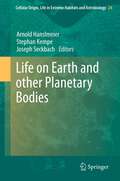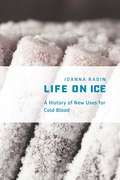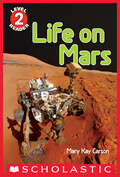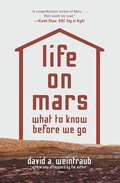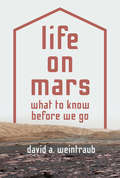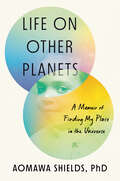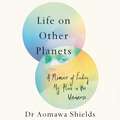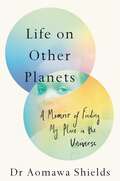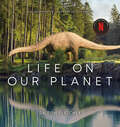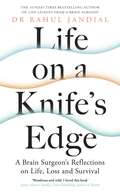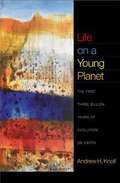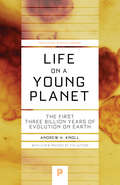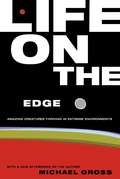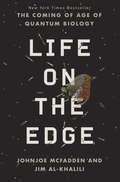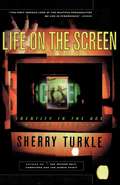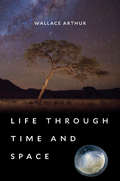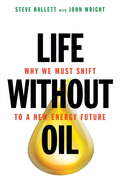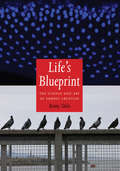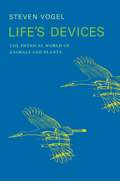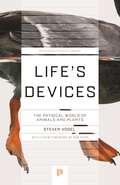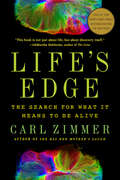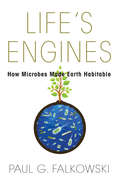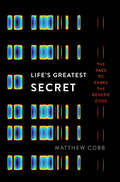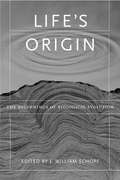- Table View
- List View
Life on Earth and other Planetary Bodies
by Joseph Seckbach Arnold Hanslmeier Stephan KempeA trio of editors [Professors from Austria, Germany and Israel] present Life on Earth and other Planetary Bodies. The contributors are from twenty various countries and present their research on life here as well as the possibility for extraterrestrial life. This volume covers concepts such as life's origin, hypothesis of Panspermia and of life possibility in the Cosmos. The topic of extraterrestrial life is currently 'hot' and the object of several congresses and conferences. While the diversity of "normal" biota is well known, life on the edge of the extremophiles is more limited and less distributed. Other subjects discussed are Astrobiology with the frozen worlds of Mars, Europa and Titan where extant or extinct microbial life may exist in subsurface oceans; conditions on icy Mars with its saline, alkaline, and liquid water which has been recently discovered; chances of habitable Earth-like [or the terrestrial analogues] exoplanets; and SETI's search for extraterrestrial Intelligence.
Life on Ice: A History of New Uses for Cold Blood
by Joanna RadinAfter the atomic bombing at the end of World War II, anxieties about survival in the nuclear age led scientists to begin stockpiling and freezing hundreds of thousands of blood samples from indigenous communities around the world. These samples were believed to embody potentially invaluable biological information about genetic ancestry, evolution, microbes, and much more. Today, they persist in freezers as part of a global tissue-based infrastructure. In Life on Ice, Joanna Radin examines how and why these frozen blood samples shaped the practice known as biobanking. The Cold War projects Radin tracks were meant to form an enduring total archive of indigenous blood before it was altered by the polluting forces of modernity. Freezing allowed that blood to act as a time-traveling resource. Radin explores the unique cultural and technical circumstances that created and gave momentum to the phenomenon of life on ice and shows how these preserved blood samples served as the building blocks for biomedicine at the dawn of the genomic age. In an era of vigorous ethical, legal, and cultural debates about genetic privacy and identity, Life on Ice reveals the larger picture—how we got here and the promises and problems involved with finding new uses for cold human blood samples.
Life on Mars (Scholastic Reader, Level 2)
by Mary Kay CarsonDiscover the truth about life on Mars in this level 2 reader!Mars is a cold, desert planet with no water. But it wasn't always like this. Could there once have been living things there? Find out in this new level 2 reader all about life on Mars. Includes the most stunning and up-to-date photographs from NASA.
Life on Mars: What to Know Before We Go
by David A. WeintraubThe search for life on Mars—and the moral issues confronting us as we prepare to send humans thereDoes life exist on Mars? The question has captivated humans for centuries, but today it has taken on new urgency. As space agencies gear up to send the first manned missions to the Red Planet, we have a responsibility to think deeply about what kinds of life may already dwell there—and whether we have the right to invite ourselves in. Telling the complete story of our ongoing quest to answer one of the most tantalizing questions in astronomy, David Weintraub grapples with the profound moral and ethical questions confronting us as we prepare to introduce an unpredictable new life form—ourselves—into the Martian biosphere. Now with an afterword that discusses the most recent discoveries, Life on Mars explains what we need to know before we go.
Life on Mars: What to Know Before We Go
by David WeintraubThe story of the search for life on Mars—and the moral issues confronting us as we prepare to send humans thereDoes life exist on Mars? The question has captivated humans for centuries, but today it has taken on new urgency. NASA plans to send astronauts to Mars orbit by the 2030s. SpaceX wants to go by 2024, while Mars One wants to land a permanent settlement there in 2032. As we gear up for missions like these, we have a responsibility to think deeply about what kinds of life may already inhabit the planet--and whether we have the right to invite ourselves in. This book tells the complete story of the quest to answer one of the most tantalizing questions in astronomy. But it is more than a history. Life on Mars explains what we need to know before we go.David Weintraub tells why, of all the celestial bodies in our solar system, Mars has beckoned to us the most. He traces how our ideas about life on Mars have been refined by landers and rovers, terrestrial and Mars-orbiting telescopes, spectroscopy, and even a Martian meteorite. He explores how finding DNA-based life on the Red Planet could offer clues about our distant evolutionary past, and grapples with the profound moral and ethical questions confronting us as we prepare to introduce an unpredictable new life form—ourselves—into the Martian biosphere.Life on Mars is also a book about how science is done—and undone—in the age of mass media. It shows how Mars mania has obscured our vision since we first turned our sights on the planet and encourages a healthy skepticism toward the media hype surrounding Mars as humanity prepares to venture forth.
Life on Other Planets: A Memoir of Finding My Place in the Universe
by Aomawa ShieldsA stunning and inspiring memoir charting a life as an astronomer, classically-trained actor, mother, and Black woman in STEM, searching for life in the universe while building a meaningful life here on EarthAs a kid, Aomawa Shields was always bumping into things, her neck craned up at the sky, dreaming of becoming an astronaut. A year into an astrophysics PhD program, plagued by self-doubt and discouraged by a white male professor who suggested that she—a young Black woman who also loved fashion, makeup, and the arts—didn&’t belong, she left astronomy and pursued acting professionally for a decade, before a day job working for NASA&’s Spitzer Space Telescope drew her back to the stars. She was the oldest and the only Black student in her PhD cohort. This time, no professor, and no voice in her own head, would stop her. Now an astronomer and astrobiologist at the top of her field, Dr. Shields studies the universe outside our Solar System, researching and uncovering the planets circling distant stars with just the right conditions that could support life—while also using her theater education to communicate the wonder and magic of the universe with those of us here on Earth. But it&’s been a journey as winding and complex as the physics she has mastered. Life on Other Planets is a journey of discovery on this world and on others, a story of creating a life that makes space for joy, love, and wonder while being driven by one of our biggest questions: Is anybody else out there? It is about the possibility of living between multiple worlds and not choosing—but instead charting a new path entirely.
Life on Other Planets: A Memoir of Finding My Place in the Universe
by Aomawa ShieldsAs a child, Aomawa Shields was always bumping into things, her neck craned up at the sky, dreaming of becoming an astronaut. A year into an astrophysics PhD program, plagued by self-doubt and discouraged by a white male professor who suggested that she - a young Black woman who also loved fashion, makeup, and the arts - didn't belong, she left astronomy and pursued acting professionally for a decade, before a day job working for NASA's Spitzer Space Telescope drew her back to the stars. She was the oldest and the only Black student in her PhD cohort. This time, no professor, and no voice in her own head, would stop her.Now an astronomer and astrobiologist at the top of her field, Dr Shields studies the universe outside our solar system, researching and uncovering the planets circling distant stars with just the right conditions that could support life. But it's been a road as winding and complex as the physics she has mastered.Life on Other Planets is a journey of discovery on this world and on others, a story of creating a life that makes space for joy, love and wonder while being driven by one of our biggest questions: is anybody else out there? It is about the possibility of living between multiple worlds and not choosing - but instead charting a new path entirely.
Life on Other Planets: A Memoir of Finding My Place in the Universe
by Aomawa ShieldsAs a child, Aomawa Shields was always bumping into things, her neck craned up at the sky, dreaming of becoming an astronaut. A year into an astrophysics PhD program, plagued by self-doubt and discouraged by a white male professor who suggested that she - a young Black woman who also loved fashion, makeup, and the arts - didn't belong, she left astronomy and pursued acting professionally for a decade, before a day job working for NASA's Spitzer Space Telescope drew her back to the stars. She was the oldest and the only Black student in her PhD cohort. This time, no professor, and no voice in her own head, would stop her.Now an astronomer and astrobiologist at the top of her field, Dr Shields studies the universe outside our solar system, researching and uncovering the planets circling distant stars with just the right conditions that could support life. But it's been a road as winding and complex as the physics she has mastered.Life on Other Planets is a journey of discovery on this world and on others, a story of creating a life that makes space for joy, love and wonder while being driven by one of our biggest questions: is anybody else out there? It is about the possibility of living between multiple worlds and not choosing - but instead charting a new path entirely.
Life on Our Planet: A Stunning Re-examination of Prehistoric Life on Earth
by Tom FletcherAn unforgettable journey into our ancient past, containing powerful lessons to learn about our future.Today there are 20 million species on our planet. Yet what we see is just a snapshot in time. 99% of earth's inhabitants are lost to our deep past. The story of what happened to these lineages—their rise and their fall—is truly remarkable.Accompanying the ground-breaking Netflix series, Life on our Planet uses the latest technology to bring long-extinct creatures back to life. It tells the story of life's epic battle to conquer and survive on Earth, showing in a new light what's been lost to us, and how life's future is now being written by us. From ancient ocean worlds and plant life's first forays onto land, to the rise and fall of the dinosaurs and the devastation of the last Ice Age, this is a sweeping view of evolution, through five extinctions and, with the arrival of humans on earth, the beginning of the sixth...With over 200 photos and images from the series created by the team behind the original Planet Earth series, including remarkable CGI reconstructions, this is an unforgettable journey into our ancient past, containing powerful lessons to learn about our future.
Life on a Knife’s Edge: A Brain Surgeon’s Reflections on Life, Loss and Survival
by Dr Rahul Jandial'It's a brilliant book... There are lessons in every paragraph... Get it now.' Chris Evans'Wonderous and wild. I loved this book' James Nestor, bestselling author of Breath 'Moving, raw and unflinching' Julia Samuel, bestselling author of This Too Shall Pass'Incredible storytelling' Dr Rangan Chatterjee, bestselling author of Feel Better in 5____________________________________________________________________________How do you carry on when things go deadly wrong?When Dr Rahul Jandial operated on Karina, an eleven-year-old girl whose spinal cord was splitting in two, he had to make an impossible decision. He followed his head over his gut and Karina was left permanently paralysed, altering both patient and surgeon's lives for ever. This decision would haunt Rahul for decades, a constant reminder of the fine line between saving and damaging a life.As one of the world's leading brain surgeons, Rahul is the last hope for patients with extreme forms of cancer. In treating them, he has observed humanity at its most raw and most robust. He has journeyed to unimaginable extremes with them, guiding them through the darkest moments of their lives.Life on a Knife's Edge is Rahul's poetic and beautifully written account of the resilience, courage and belief he has witnessed in his patients, and the lessons about human nature he has learned from them. It is about the impossible choices he has to make, and the fateful consequences he is forced to live with.From challenging the ethics of surgical practices, to helping a patient with locked-in syndrome communicate her dying wish to her family, Rahul shares his extraordinary experiences, revealing the depths of a surgeon's psyche that is continuously pushed to its limits.
Life on a Young Planet: The First Three Billion Years of Evolution on Earth
by Andrew H. KnollThe author presents a compelling new explanation for the evolution as he takes us deep into history of life, thereby helping readers understand how the biological diversity that surrounds us, came to existence.
Life on a Young Planet: The First Three Billion Years of Evolution on Earth
by Andrew H. KnollAustralopithecines, dinosaurs, trilobites--such fossils conjure up images of lost worlds filled with vanished organisms. But in the full history of life, ancient animals, even the trilobites, form only the half-billion-year tip of a nearly four-billion-year iceberg. Andrew Knoll explores the deep history of life from its origins on a young planet to the incredible Cambrian explosion, presenting a compelling new explanation for the emergence of biological novelty. The very latest discoveries in paleontology--many of them made by the author and his students--are integrated with emerging insights from molecular biology and earth system science to forge a broad understanding of how the biological diversity that surrounds us came to be. Moving from Siberia to Namibia to the Bahamas, Knoll shows how life and environment have evolved together through Earth's history. Innovations in biology have helped shape our air and oceans, and, just as surely, environmental change has influenced the course of evolution, repeatedly closing off opportunities for some species while opening avenues for others. Readers go into the field to confront fossils, enter the lab to discern the inner workings of cells, and alight on Mars to ask how our terrestrial experience can guide exploration for life beyond our planet. Along the way, Knoll brings us up-to-date on some of science's hottest questions, from the oldest fossils and claims of life beyond the Earth to the hypothesis of global glaciation and Knoll's own unifying concept of ''permissive ecology.'' In laying bare Earth's deepest biological roots, Life on a Young Planet helps us understand our own place in the universe--and our responsibility as stewards of a world four billion years in the making. In a new preface, Knoll describes how the field has broadened and deepened in the decade since the book's original publication.
Life on the Edge: Amazing Creatures Thriving in Extreme Environments
by Michael GrossCan life exist in the Antarctic ice, in the deep subsurface, in dilute sulfuric acid, in hot springs-even on Mars? What degree of high or low temperature, pressure, or salt concentration can living cells tolerate? In recent years, scientists have discovered many single-cell creatures that exist in-in fact, are perfectly adapted to-extreme environments that were considered uninhabitable just one or two decades ago. In Life on the Edge, author Michael Gross explores how microorganisms adapt to their hostile environments and how they affect our current definition of the "normal" conditions for life. He also describes the vast implications of these extremophiles and other amazing creatures-from potential breakthroughs in medicine and biotechnology to the search for life elsewhere in the universe.
Life on the Edge: The Coming of Age of Quantum Biology
by Jim Al-Khalili Johnjoe McfaddenLife is the most extraordinary phenomenon in the known universe; but how did it come to be? Even in an age of cloning and artificial biology, the remarkable truth remains: nobody has ever made anything living entirely out of dead material. Life remains the only way to make life. Are we still missing a vital ingredient in its creation? Like Richard Dawkins' The Selfish Gene, which provided a new perspective on how evolution works, Life on the Edge alters our understanding of our world's fundamental dynamics. Bringing together first-hand experience at the cutting edge of science with unparalleled gifts of explanation, Jim Al-Khalili and Johnjoe Macfadden reveal that missing ingredient to be quantum mechanics; the phenomena that lie at the heart of this most mysterious of sciences. Drawing on recent ground-breaking experiments around the world, each chapter in Life on the Edge engages by illustrating one of life's puzzles: How do migrating birds know where to go? How do we really smell the scent of a rose? How do our genes copy themselves with such precision? Life on the Edge accessibly reveals how quantum mechanics can answer these probing questions of the universe. Guiding the reader through the rapidly unfolding discoveries of the last few years, Al-Khalili and McFadden communicate the excitement of the explosive new field of quantum biology and its potentially revolutionary applications, while offering insights into the biggest puzzle of all: what is life? As they brilliantly demonstrate in these groundbreaking pages, life exists on the quantum edge.From the Hardcover edition.
Life on the Screen: Identity in the Age of the Internet
by Sherry TurkleLife on the Screen is a book not about computers, but about people and how computers are causing us to re-evaluate our identities in the age of the Internet. We are using life on the screen to engage in new ways of thinking about evolution, relationships, politics, sex, and the self. Life on the Screen traces a set of boundary negotiations, telling the story of the changing impact of the computer on our psychological lives and our evolving ideas about minds, bodies, and machines. What is emerging, Turkle says, is a new sense of identity-- as decentered and multiple. She describes trends in computer design, in artificial intelligence, and in people's experiences of virtual environments that confirm a dramatic shift in our notions of self, other, machine, and world. The computer emerges as an object that brings postmodernism down to earth.
Life through Time and Space
by Wallace ArthurAll humans share three origins: the beginning of our individual lives, the appearance of life on Earth, and the formation of our planetary home. Wallace Arthur combines embryological, evolutionary, and cosmological perspectives to tell the story of life on Earth and its potential to exist elsewhere in the universe.
Life without Oil: Why We Must Shift to a New Energy Future
by Steve HallettBy the end of the 21st century, our oil and natural gas supplies will be virtually nonexistent, and limited coal supplies will be restricted to only a handful of countries. The authors - an environmental scientist and veteran journalist - make abundantly clear that we must plan for a future without reliance on oil, and make a compelling case that the key determinant of our global economy is not so much the invisible hand of the marketplace but the inexorable laws of ecology. They foresee the coming decades as a time of much disruption and change of lifestyle, but in the end we may learn a wiser, more sustainable stewardship of our natural resources. This timely, sobering, yet constructive discussion of energy and ecology offers a realistic vision of the near future and many important lessons about the limits of our resources.
Life's Blueprint
by Benny ShiloIn the span of just three decades, scientific understanding of the formation of embryos has undergone a major revolution. The implications of these new research findings have an immediate bearing on human health and future therapies, yet most nonscientists remain quite unaware of the exciting news. In this engaging book, a distinguished geneticist offers a clear, jargon-free overview of the field of developmental biology. Benny Shilo transforms complicated scientific paradigms into understandable ideas, employing an array of photographic images to demonstrate analogies between the cells of an embryo and human society. Shilo's innovative approach highlights important concepts in a way that will be intuitive and resonant with readers' own experiences. The author explains what is now known about the mechanisms of embryonic development and the commanding role of genes. For each paradigm under discussion, he provides both a scientific image and a photograph he has taken in the human world. These pairs of images imply powerful metaphors, such as the similarities between communication among cells and among human beings, or between rules embedded in the genome and laws that govern human society. The book concludes with a glimpse of promising future possibilities, including the generation of tissues and organs for use as "spare parts. "
Life's Devices: The Physical World of Animals and Plants
by Steven VogelThis entertaining and informative book describes how living things bump up against non-biological reality. "My immodest aim," says the author, "is to change how you view your immediate surroundings." He asks us to wonder about the design of plants and animals around us: why a fish swims more rapidly than a duck can paddle, why healthy trees more commonly uproot than break, how a shark manages with such a flimsy skeleton, or how a mouse can easily survive a fall onto any surface from any height. The book will not only fascinate the general reader but will also serve as an introductory survey of biomechanics. On one hand, organisms cannot alter the earth's gravity, the properties of water, the compressibility of air, or the behavior of diffusing molecules. On the other, such physical factors form both constraints with which the evolutionary process must contend and opportunities upon which it might capitalize. Life's Devices includes examples from every major group of animals and plants, with references to recent work, with illustrative problems, and with suggestions of experiments that need only common household materials.
Life's Devices: The Physical World of Animals and Plants (Princeton Science Library)
by Steven VogelAn entertaining and informative book that explores how living things contend with nonbiological realityLife on Earth is subject to the pull of gravity, the properties of air and water, and the behavior of diffusing molecules, yet such physical factors are constraints that drive evolution and offer untold opportunities to creatures of all sizes. In this lively introduction to the science of biomechanics, Steven Vogel invites you to wonder about the design of the plants and animals around us. You will learn why a fish swims more rapidly than a duck can paddle, why healthy trees more commonly uproot than break, how sharks manage with such flimsy skeletons, and why a mouse can easily survive a fall onto any surface from any height. With an illuminating foreword by Rob Dunn, this Princeton Science Library edition of Life&’s Devices includes examples from every major group of animals and plants along with illustrative problems and suggestions for experiments that require only common household materials.
Life's Edge: The Search for What It Means to Be Alive
by Carl Zimmer&“Carl Zimmer is one of the best science writers we have today.&”—Rebecca Skloot, author of The Immortal Life of Henrietta Lacks We all assume we know what life is, but the more scientists learn about the living world—from protocells to brains, from zygotes to pandemic viruses—the harder they find it is to locate life&’s edge. Carl Zimmer investigates one of the biggest questions of all: What is life? The answer seems obvious until you try to seriously answer it. Is the apple sitting on your kitchen counter alive, or is only the apple tree it came from deserving of the word? If we can&’t answer that question here on earth, how will we know when and if we discover alien life on other worlds? The question hangs over some of society&’s most charged conflicts—whether a fertilized egg is a living person, for example, and when we ought to declare a person legally dead. Life's Edge is an utterly fascinating investigation that no one but one of the most celebrated science writers of our generation could craft. Zimmer journeys through the strange experiments that have attempted to re-create life. Literally hundreds of definitions of what that should look like now exist, but none has yet emerged as an obvious winner. Lists of what living things have in common do not add up to a theory of life. It's never clear why some items on the list are essential and others not. Coronaviruses have altered the course of history, and yet many scientists maintain they are not alive. Chemists are creating droplets that can swarm, sense their environment, and multiply. Have they made life in the lab? Whether he is handling pythons in Alabama or searching for hibernating bats in the Adirondacks, Zimmer revels in astounding examples of life at its most bizarre. He tries his own hand at evolving life in a test tube with unnerving results. Charting the obsession with Dr. Frankenstein's monster and how Coleridge came to believe the whole universe was alive, Zimmer leads us all the way into the labs and minds of researchers working on engineering life from the ground up.
Life's Engines: How Microbes Made Earth Habitable
by Paul G. FalkowskiFor almost four billion years, microbes had the primordial oceans all to themselves. The stewards of Earth, these organisms transformed the chemistry of our planet to make it habitable for plants, animals, and us. Life's Engines takes readers deep into the microscopic world to explore how these marvelous creatures made life on Earth possible--and how human life today would cease to exist without them.Paul Falkowski looks "under the hood" of microbes to find the engines of life, the actual working parts that do the biochemical heavy lifting for every living organism on Earth. With insight and humor, he explains how these miniature engines are built--and how they have been appropriated by and assembled like Lego sets within every creature that walks, swims, or flies. Falkowski shows how evolution works to maintain this core machinery of life, and how we and other animals are veritable conglomerations of microbes.A vibrantly entertaining book about the microbes that support our very existence, Life's Engines will inspire wonder about these elegantly complex nanomachines that have driven life since its origin. It also issues a timely warning about the dangers of tinkering with that machinery to make it more "efficient" at meeting the ever-growing demands of humans in the coming century.
Life's Engines: How Microbes Made Earth Habitable (Princeton Science Library #137)
by Paul G. FalkowskiThe marvelous microbes that made life on Earth possible and support our very existenceFor almost four billion years, microbes had the primordial oceans all to themselves. The stewards of Earth, these organisms transformed the chemistry of our planet to make it habitable for plants, animals, and us. Life's Engines takes readers deep into the microscopic world to explore how these marvelous creatures made life on Earth possible—and how human life today would cease to exist without them.Paul Falkowski looks "under the hood" of microbes to find the engines of life, the actual working parts that do the biochemical heavy lifting for every living organism on Earth. With insight and humor, he explains how these miniature engines are built—and how they have been appropriated by and assembled like Lego sets within every creature that walks, swims, or flies. Falkowski shows how evolution works to maintain this core machinery of life, and how we and other animals are veritable conglomerations of microbes.A vibrantly entertaining book about the microbes that support our very existence, Life's Engines will inspire wonder about these elegantly complex nanomachines that have driven life since its origin. It also issues a timely warning about the dangers of tinkering with that machinery to make it more "efficient" at meeting the ever-growing demands of humans in the coming century.
Life's Greatest Secret: The Race to Crack the Genetic Code
by Matthew CobbEveryone has heard of the story of DNA as the story of Watson and Crick and Rosalind Franklin, but knowing the structure of DNA was only a part of a greater struggle to understand life’s secrets. Life’s Greatest Secret is the story of the discovery and cracking of the genetic code, the thing that ultimately enables a spiraling molecule to give rise to the life that exists all around us. This great scientific breakthrough has had farreaching consequences for how we understand ourselves and our place in the natural world, and for how we might take control of our (and life’s) future. Life’s Greatest Secret mixes remarkable insights, theoretical dead-ends, and ingenious experiments with the swift pace of a thriller. From New York to Paris, Cambridge, Massachusetts, to Cambridge, England, and London to Moscow, the greatest discovery of twentieth-century biology was truly a global feat. Biologist and historian of science Matthew Cobb gives the full and rich account of the cooperation and competition between the eccentric characters--mathematicians, physicists, information theorists, and biologists--who contributed to this revolutionary new science. And, while every new discovery was a leap forward for science, Cobb shows how every new answer inevitably led to new questions that were at least as difficult to answer: just ask anyone who had hoped that the successful completion of the Human Genome Project was going to truly yield the book of life, or that a better understanding of epigenetics or "junk DNA” was going to be the final piece of the puzzle. But the setbacks and unexpected discoveries are what make the science exciting, and it is Matthew Cobb’s telling that makes them worth reading. This is a riveting story of humans exploring what it is that makes us human and how the world works, and it is essential reading for anyone who’d like to explore those questions for themselves.
Life's Origin: The Beginnings of Biological Evolution
by J. William SchopfThis volume explores the historical and current theories about the origin of life, addressing in particular the three key puzzles of how and when life began on Earth and in what form.
